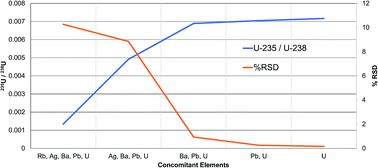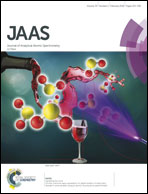Concomitant ion effects on isotope ratio measurements with liquid sampling – atmospheric pressure glow discharge ion source Orbitrap mass spectrometry
Abstract
In an effort to understand and improve the accuracy and precision of the liquid sampling-atmospheric pressure glow discharge (LS-APGD)/Orbitrap system, effects of concomitant ions on the acquired mass spectra are examined and presented. The LS-APGD/Orbitrap instrument system is capable of high quality isotope ratio measurements, which are of high analytical interest for nuclear non-proliferation detection applications. The presence of background and concomitant ions (water clusters, matrix, and other analytes) has presented limitations in earlier studies. In order to mitigate these effects, an alternative quadrupole-Orbitrap hybrid mass spectrometer was employed in this study. This instrument configuration has a quadrupole mass filter preceding the Orbitrap to filter-out undesired non-analyte ions. Results are presented for the analysis of U in the presence of Rb, Ag, Ba, and Pb as concomitants, each present at 0.5 μg mL−1 concentration. Progressive filtering of each concomitant ion shows steadily improved U isotope ratio performance. Ultimately, a 235U/238U ratio of 0.007133, with a relative error of −2.1% and a relative standard deviation of 0.087% was achieved using this system, along with improved calibration linearity and lowered limits of detection. This performance is surprisingly good for an ion trap type mass spectrometry instrument.



 Please wait while we load your content...
Please wait while we load your content...